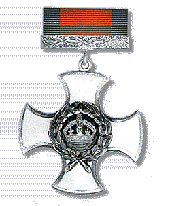Established for rewarding individual instances of meritorious or distinguished service in war. This is a purely military order and is only given to officers whose service has been marked by the special mention of his name in despatches for distinguished services under fire, or under conditions equivalent to service in actual combat with the enemy.
The DSO was introduced in 1886 following campaigns such as the Crimea and Indian Mutiny as there was, prior to that time, no adequate reward for distinguished service by junior officers, apart from the Victoria Cross.

Bar: Awarded where the individual performs an approved act of gallantry which would have entitled him to the Order in the first place.
Obverse: The badge consists of a gold cross, enamelled white, edged in gold, having in the centre within a wreath of laurel green, the Imperial Crown in gold.
Description: A gold cross, enamelled white, edged in gold.
Reverse: Within a laurel wreath of enamelled green, the Royal Cypher in gold.
Mounting: A ring at the top of the medal attaches to a smaller ring at the bottom of a gold bar ornamented with laurel. A second gold bar ornamented with laurel is worn at the top of the ribbon.
Ribbon: 1 1/8 inches wide; Red with Blue edges (ribbon is officially supposed to be 1" wide but available ribbon is 1 1/8").
Total Issued as of 1983: 1291, including 113 first bars and 18 second bars.
Captain Donald R MacLaren, DSO, MC and Bar, DFC -- awarded DSO for his actions on 24 September 1918 when he plus 3 other aircraft attacked a formation of six enemy scouts which in turn were protected by 16 aircraft overhead. MacLaren shot down one in flames bringing his total to 48 planes and 6 balloons.
The Most Honourable Order of the Bath (Companion)
The Order of the British Empire